Martinique
Destination - CaribbeanMartinique and the harbour at Le Marin form the ‘classic’ departure point for the Grenadines. However, this superb island conceals some fabulous ‘secret places’ and amply repays several days cruising spent cruising there...
It all began at the Paris Boat Show, during a discussion with Eric Vasse, from Punch Croisières: “and when are you going to come back to Martinique to sail?” I lived for a long time on the “'île aux fleurs", and am very attached to it, for both friendly and family reasons. “You’re right”, I replied “ but the idea of sailing down to the Grenadines and beating back with the children in less than a week doesn’t really appeal...” “Exactly”, replied Eric shrewdly, “have a look at the windward coast, it’s absolutely magical, and no one ever goes there...”
No sooner said than done, and we were off to discover an island that I thought, wrongly, I knew inside out!
After an uneventful flight, we arrived at the Aimé Césaire du Lamentin airport. Our shuttle was waiting for us when we left the aeroplane, and less than two hours after having set foot in Martinique, we were sipping our first punch in the marina at Le Marin, a few cables from our Nautitech 44, which was proudly awaiting its crew to set off... Shortly after our baggage had been stowed in the cockpit, we left the marina to go and anchor at Sainte-Anne. The anchorage off Caritan creek was much more pleasant than a night in the marina. Especially as jet lag meant that we would probably wake up at the crack of dawn. In fact we were all awake at 3 o’clock in the morning. We ate breakfast whilst watching the sun rise, and our first swim at dawn was very invigorating... It was time to return to the marina to finish provisioning and pick up our skipper...
A deserted area...with no buoys!
We had in fact organised our little trip to go and discover Martinique’s windward coast. The idea was to find the good anchorages between Les Salines in the south and Robert Bay in the north. An area which can be full of traps for the unwary, as there are many rocks but a lot less buoys to mark them! We had therefore called on a skipper who knew the area well. Jean-Michel was not just a professional skipper, used to sailing catamarans, but also a fisherman, whose fishing area stretched over the whole of the windward coast. With such help, we hoped to have an abundance of fish, and access to anchorages in the most remote spots.
At 7 o’clock in the morning, we were back in our marina berth in Le Marin. After taking on provisions for a week, and preparing the navigation with Jean-Michel, we were off again. The exit from the marina at Le Marin was still as beautiful: there were many boats at anchor and the water was sometimes emerald blue, sometimes deep blue. We passed in front of the Club Med, and could at last hoist the sails. Our boat was a 2006 Nautitech 44, a four-cabin version in which we would be particularly comfortable, as there were only five of us aboard - three adults, two children, and quite a few friends and family who were to join us at the stopovers...
After Saint-Anne, we rounded the southerly tip of Martinique to head for the Atlantic, which was to be our playground for the coming days.
On the way, we discovered the ‘Anse Moustique’ (well-known worldwide as a gay beach...) and the beach at Les Salines. Opposite was the small island of Cabrits, and further on, the ‘Table du Diable’. This is a really exceptional anchorage, less than four miles from the marina. Beware however, this is a daytime-only anchorage, as the nearby Atlantic can cause an unpleasant and quite violent swell. This first stop will also allow you to discover the richness of the underwater fauna. All you need is a mask, fins and snorkel to enjoy this pretty diving area. As in ALL the coming anchorages, we were alone. There was not another boat to be seen. The only ones we saw were those leaving for the Grenadines. Poor things, they didn’t know what they were missing! It was at this exact spot, between the Pointe des Salines and Cabrits islet that I understood that Jean-Michel would be a great help to us during our cruise. We could see the water becoming shallower by the moment, (confirmed by the on-board instruments, which showed that we were already aground), and there were (many) rocks all around us, but as the wind freshened to 25 knots, accompanied by a big Atlantic swell, we tacked and tacked again, slaloming between rocks we could not see with the naked eye, but which were just a few centimetres from our keels. A really beautiful sail... Aboard, everyone had their role: the skipper at the helm, the first mate (me) on the genoa winches and the ship’s boy on the mainsheet traveller... The others were having a drink!
Once we had passed the Table au Diable, we sailed up towards the Baie des Anglais. Strenuous sailing, to windward, and a (difficult) encounter with the Atlantic swell. Aboard we were all starting to feel quite seasick. Fortunately the wind quickly turned south-easterly, and we had a beam wind of around 25 knots. The Nautitech 44 got into its stride, and we hardly had time to appreciate the Anse Trabaud, before the entrance to the Baie des Anglais appeared ahead of us. Rather, when I say that it appeared, I should have said that it could be made out. There were breakers all around us, and we were being thrown about a lot, then, suddenly, flat calm. We had entered! The Baie des Anglais is an absolutely superb place, completely wild. To starboard, Hardy Island is a nature reserve. Landing is forbidden and mooring buoys are used so as not to damage the seabed. The day we visited, there was nobody there. During the day, you may see a day-charter boat approach, but mostly at the weekend. It was the middle of the week and we had the Baie des Anglais to ourselves. We had decided to spend the night here. To anchor peacefully, go deep into the bay, where you will find yourself in the mangrove, an environment which is both reassuring (you are well-protected) and strange. Be careful, however, as this is not a place for monohulls or boats with a draft of more than two metres. Finally, at the end of the afternoon, two other catamarans came to join us in our peaceful haven, but there is so much space available that we hardly saw them...
The following morning, we regretfully left our anchorage, for the Atlantic swell... As we left the Baie des Anglais, we discovered a catamaran aground which had been partially destroyed by hurricane Dean – one of the rare traces of this terrible phenomenon which can still be seen, and one which damages this bay’s reputation as a ‘hurricane hole’...
Passe Sud du Vauclin: sheltered at last
It was to be a busy day, as we wanted to explore all the possible anchorages between the Baie des Anglais and the Baignoire de Joséphine... We began by leaving the Baie des Anglais and returning to the Atlantic swell, which hadn’t subsided much since the day before. Fortunately, the wind had remained in the south-east, and we sped downwind with a good breeze of more than 20 knots – a point of sailing which suited our catamaran perfectly, but our excessive speed prevented us from fishing effectively... At least, that’s what our fisherman-skipper claimed, when he remained empty-handed! Fortunately, I was used to sailing fast (and therefore catching nothing), so the fridge was full! The most annoying thing was that the speed record for our cruise was to be beaten by...the ship’s boy (12), who obviously steered much better than Jean-Michel, a professional skipper, and the poor editor-in-chief of the magazine you have in your hands...
Our day’s first stage took us to Cap Chevalier, a well-known Martinique beach, ideal for discovering the joys of windsurfing... The anchorage (daytime only) off the small island of Chevalier is superb, but the seabed was not far from our keels. The advantage was that we didn’t have to veer much chain to anchor... The real problem was reaching the anchorage, as the entrance is not very wide, badly buoyed (I am still looking for the buoy Jean-Michel claimed to have seen) and the day we visited, the entrance was quite ‘sporting’, amidst the breakers. But again, once you have entered, you are in paradise... After this pretty stop, we set off again towards the south entrance of the Vauclin, as aboard, the crew were still quite seasick. We could not get used to the unpleasant crossed swell. We therefore sped towards the entrance to the Vauclin, where we would (finally) be sheltered from the seas, thanks to the big rocks which protected the whole area as far as Robert...
Nothing is simple in this area... The south entrance to the Vauclin was marked by a single red buoy (that we were supposed to leave to starboard – West Indian buoyage area). “And where’s the green?” I inquired slightly anxiously from the steering position... “Don’t worry,” the skipper, (who was playing cards with the children) replied mockingly, “you will see a rock just above the surface of the water. Go between the red buoy and the rock ...” And as if that was not enough, we also had to slalom between the numerous lobster pots which covered the seabed in the entrance. These pots are attached to a plastic bottle, a can or some other kind of float with a ‘string’ just waiting to trap you. It is better to sail than to motor. Meanwhile, I had my revenge, as we lost another lure, which was ‘swallowed up’ by a lobster pot... And we had still not caught a single fish... That evening, we would eat spaghetti à la napolitaine...
After passing the town of Vauclin, we arrived at what was to be the most beautiful anchorage of our cruise: Petite Grenade...
The entrance was once again very narrow. But at least here, as we were protected from the swell by the reef, the waves were not breaking all around us. So much the better, moreover, as the seabed was really not far below us. We entered – just! Petite Grenade is a real ‘hurricane hole’. A very peaceful spot, where you don’t risk meeting unwelcome people. Off the small island of Grenade, along the rocks, the diving is superb. Inside, behind the small island, the atmosphere is more like that of the mangrove, but the scenery is fantastic! We would have liked to have stayed for the night, but we had to leave again quickly, as we had to sail as far as François, whose entrance, although well-marked, is not that easy to go through at night... There are shoals everywhere, and as usual, there were breakers all around us. We sped through the entrance at nearly 10 knots, under full mainsail and genoa. There’s no doubt about it, catamarans are great fun!
The anchorage is between the small islands of Oscar and Thiery. This is the famous ‘Baignoires de Joséphine’. We don’t really know if the Empress –to-be actually bathed there, but the place has kept her name. It is a sandy shoal, where you can bathe in less than a metre of water. In front of you is the Atlantic; behind, in the distance, Martinique. Obviously we were alone at the anchorage. It is excellent and well-protected, even though it is not accessible to boats with a big draft... A final detail, but an important one - this place is magic, exceptional, fabulous, but there is one slight problem: at around 10 o’clock in the morning, until 3 or 4 o’clock in the afternoon, you will see the Roi Mongin arrive. This is one (or several) boat(s), loaded with hundreds of tourists, who have come to be baptised in rum in the ‘Baignoire de Joséphine’. On their programme: rum, loud music and a barbecue. We therefore advise you to abandon the anchorage before the hordes arrive! With a good chart and good eyes, the Baie du François is teeming with pleasant, completely deserted anchorages. You will even discover crayfish and enough to vastly improve the daily fare aboard. But we had to speed on to the Baie du Robert. And on the way, there were obviously no fish...
The Baie du Robert
The next morning, we were quietly having breakfast, quite early, as we were still affected by jet-lag, when we saw some kayaks in the distance... The tourists get up really early at this time of year, especially as the François marina is not exactly next door... But by looking closely, we discovered a characteristic khaki colour: they were in fact army commandos who have a training base at François. This morning, they had come as far as the Baignoires by kayak, armed and in full kit. And of course, only the first to arrive is allowed to refresh himself by bathing fully clothed. The others watched him, then left again quickly to continue their programme.
We too were ready to get under way. We went back through the François pass, towards the small island of Loup-Garou, off Robert. This is a tiny island, capped by a coconut tree, and is a pleasant daytime anchorage, especially as the snorkelling here is very pretty... Great care must be taken, however, with the current, which can be strong.
We then headed toward the Baie du Robert. Access here is very easy and the buoyage is perfect; many commercial ships stop over here... The Baie du Robert is a very beautiful bay, deep and well-protected. You could easily spend several days here, discovering the various different nooks and crannies. As far as we were concerned, we had a young sailor aboard who was passionate about dragons. No problem – Jean-Michel took us to the small island of Chancel, whose peculiarity is that it is home to a unique and endemic population of iguanas (iguana delicatissima), which are only to be found in Martinique. The visit is impressive, with the (very) numerous iguanas and the ruins of the sugar refinery. But the Baie du Robert also has some superb beaches, such as the one at Trapèze, or again that on the small island of Madame, where picnic shelters have been installed by the town hall.
It was now time for us to return. We set off in the direction of Le Marin, which awaited us after five hours of pleasant sailing, two swimming stops and (finally) a good catch, as a small bonito had finally deigned to take our bait...
But if your heart is set on it, there is nothing to stop you continuing northwards, to discover the Caravelle peninsula and the superb Baie du Galion (which is a national park) or again, the Baie du Trésor.
Then, either you decide to sail right round Martinique and pass into the Caribbean, or you turn round and take the time to rediscover these magical and completely deserted places...
Our recommendations
- Strongly recommended when you go cruising in the West Indies, the ‘Guide des Antilles’, by Jacques Patuelli becomes essential once you leave the beaten track. Editions Atoll.
- If you are looking for a skipper who knows the area like the back of his hand, Jean-Michel is your man. A competent, likeable person who knows and loves his island, he will allow you to appreciate your cruise. (tel. +596 (0)6 96 94 03 69)
- Local colour: if you are anchored in the Anses d'Arlet, go and visit Claude. This painter exhibits his works on the road to the Anses d’Arlet, coming from the Trois Islets. And in addition, he offers tasty fruit juices made on request. An excellent address, especially as Claude is an old friend, so make yourself known as part of the big ‘Multihulls World’ family... (tel. +596 (0)5 96 68 65 54)
- Eating: For years we have appreciated the quality and kindness to be found at the Kaï Léger restaurant on François. Also the hotel at the Anse Caritan: when you are anchored just in front of the hotel, you can easily let yourself be tempted by an aperitif in pleasant surroundings...
Anchorages on the Caribbean coast.
So, you want to sail right round Martinique? A good idea! In fact, you will sail on all points of sailing, and will have changing sea conditions, but will have no clearance to carry out and will have a good view of what the West Indies can offer.
After the windward coast, where you will always (or almost always) be alone in the anchorages, the Caribbean side will be a complete change... At Saint Pierre, Fort de France, the Trois Ilets and even more so in the Anses d’Arlet, expect to have a lot of neighbours at anchor. But this is also a good way to make friends... Our favourite anchorages are at Marigot du Diamant, and in the Anses d’Arlet, at the Anse Chaudière.
Lobster pots: beware, danger.
Lobster pots have become a real safety problem. They are everywhere and there are far too many of them! The least little rock is literally surrounded with lobster pots. As a result, the fishermen are no longer catching fish, and the seabed is becoming emptier and emptier... As for sailing, these lobster pots mean that you have to keep a perpetual lookout. Motoring is almost impossible, and losing your trailing fishing lines is commonplace. In short, it is perhaps time to sort out this useless and disastrous over-fishing.
Charter companies for this destination
Destinations offered by
View all the destinations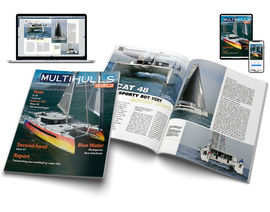
 Discover the 2025 winners!
Discover the 2025 winners! 
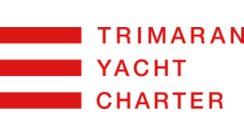
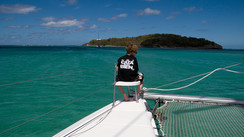
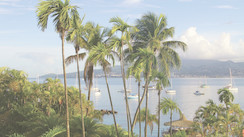
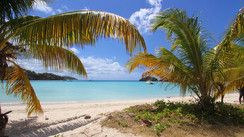
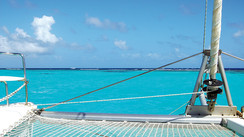
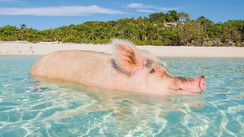
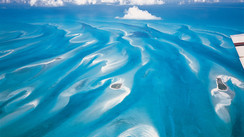







What readers think
Post a comment
No comments to show.